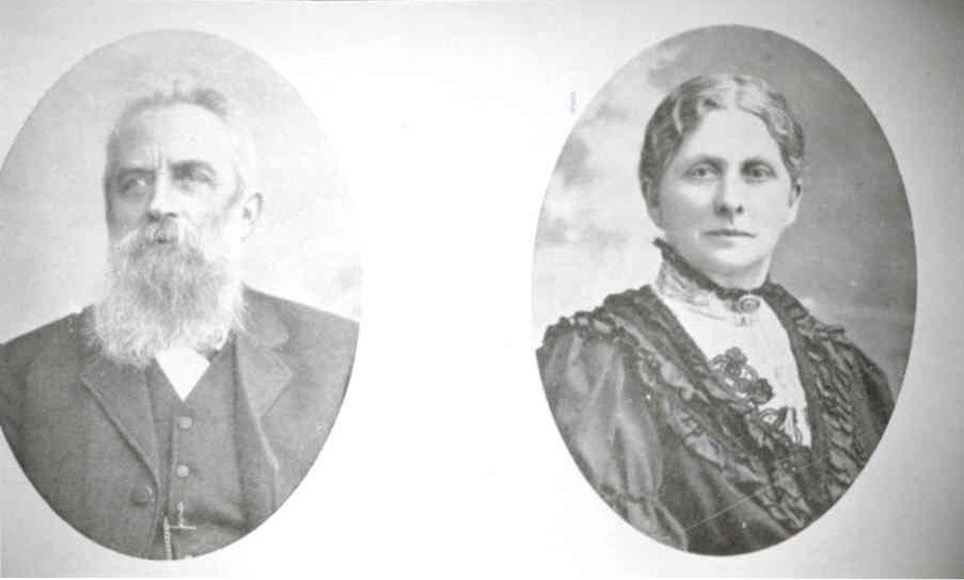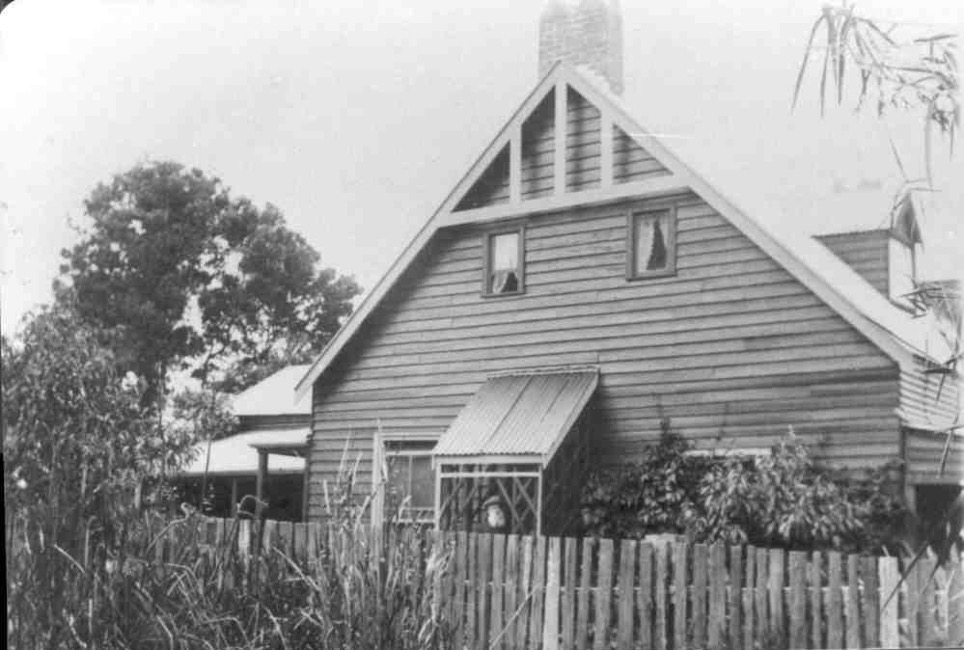 Explore the Poowong History Trail »
Explore the Poowong History Trail »
 Explore the Poowong History Trail »
Explore the Poowong History Trail »

Caleb Burchett was born to James and Maria in 1843 in Hounslow, England. He was the second eldest of five children, three boys and two girls. The family left the UK in September 1853 and arrived in Melbourne in Feb 1854. Ages of the children were James (11), Caleb (10), Joshua (8), Miriam (5) and Lydia (1).
After their arrival in Melbourne, they lived in a too-expensive rental in South Carlton for just one week, followed by a couple of months rental in Collingwood (now Fitzroy), where Maria died. Caleb described his mother’s death as “a triumph of Faith”. It was a time of great religiosity and the Burchetts were fervent in their practices and beliefs. They then moved to Brunswick, initially in a hessian and tarpaulin tent, but later his father built a brick and stone home. The family was Anglican in the UK but became Wesleyan/Methodist during the Brunswick years.
At age 20 years, his father offered to fund him several months schooling and became a pupil teacher. He met Amy Stroud, a fellow teacher at Brunswick, and he robbed the Sunday School of one of its best teachers when they were married 6 years later in 1868. Amy was born in the UK in 1843 and was 6 years younger than Caleb. She came to Australia with her parents John and Ellen Stroud in 1853. Amy and Caleb were eventually to raise 10 children between 1869 and 1885.
He built a Brunswick house in (or around) 1870, and later a two-storey residence and boot/ drapery shop in Carlton, just surviving during the poor years between 1874-76. The difficult times brought about severe illness. He determined to select land, which by then had become more available after changes to land acquisition legislation.
A family friend, Mr Littledyke suggested Poowong on the McDonalds Track, as a suitable area. His search started with a six-horse Cobb and Co coach to Dandenong; then a two-horse wagonette to Cranbourne; finally walking to Lang Lang and beyond via the steep “Tinpot” with the help of explorer and legend Jimmy Baker.
On 26 February 1876 (age 33), with the help of Mr Littledyke, Caleb pegged out and took up 319 acres at Poowong, later known as the Hazeldeane (sic) Selection. He described the site as “a forest as dark as the night”, with giant Blue gums from 200 to 400 feet. On the house site, the giant trees were 40 to the acre. He initially removed 60 trees to build the house, and later an additional 40 trees for safety. The Burchett house site was chosen on comparatively flat ground sloping into a hollow, where spring water provided plenty for household use – until years later when the land-clearing stopped the waterflow. The Burchetts later had to build an underground well.
Caleb started building his home in February 1877, one year after the block purchase. As accomplished stonemasons, and over time, they moulded 60,000 bricks from clay on his property, burnt them in a kiln and used some of these for the homestead chimneys. During the building phase, they planted 30 acres of rye grass and clover by dropping seeds in the ashes, At this stage, that’s about all they could do, so after that first few months, they returned to Brunswick in June 1877. By September, the grass was grown well enough for them to drive 40 head of cattle from Wallan Wallan to Poowong. By now, the situation was stable enough for the family to make their home in Poowong. Amy, one sister Fanny and three of the then five children then made the big move to Poowong over several trips from November 1877.

From the first, the family (of eight when the remaining two boys arrived, plus Amy’s sister Fanny) observed the Sunday Sabbath as a day of rest, but very much “missed the service and worship of god” with others in “spiritual fellowship”. So, they undertook some local advertising! In the days before internet, a notice nailed on a gum tree attracted “a good little company” on the first Sunday. The following Saturday, the community built bush seats of split blackwood, and the kitchen service was filled more comfortably the next day at what became a weekly Sunday service at Hazeldean.
Their Sunday services became an important part of community life. Legend says that once two locals were debating whether it was Sunday, and they decided they’d check to see whether Caleb’s boots were out. If so, it was Sunday.
A resolution was made by the growing congregation to build a proper church (Wesleyan/Methodist) as soon as possible for the people of Jeetho and Poowong and a good sum of money promised to erect the church. No Rules of Association, no Constitution, no Trust Fund, just honest commitments. All the timber was sawn from Caleb’s selection out of an immense blue gum felled on his property. With no need for Council approval, contractors or building supplies from elsewhere, it was completed in that same year, on 3 November 1878 and was also used as a temporary school.
This original church, now suitably de-consecrated, has survived and is called the Poowong Pioneer Chapel, on the corner of Nyora Road and Bryson St in Poowong. It is cared for by the Poowong Historical Group.
Always with a mind to the future, Caleb thought that the site of the present township of Poowong would make a useful centre, so applied to the Lands Department to have it reserved as a township.
On the civic side, Caleb was a true leader throughout this life. He was elected to the local Buln Buln Council and appointed as a JP, in what was the next phase of a busy public life. He was an active advocate for improved conditions and transport for the broader community, as well as making land available for two churches of different denominations plus what is now known as the Recreation Reserve. Private life was also busy and his family grew to ten children by 1885.
Living on the land was ever tough, and with the Melbourne economy improving Caleb and the family decided to move back to Brunswick in 1886. Wisely, they held onto the Poowong land. In 1890, Caleb and family returned to Poowong. It took many years for Poowong dairying to become broadly profitable. It was also helped by the introduction of the Separator. Ship-board refrigeration meant that butter could be exported overseas. Co-operative Butter factories were established, and the Government granted a bonus on certain standards of butter being exported to England.
The 1897/98 summer season was disastrous. An early summer with 20 days of 100 F degrees (38C) and a peak of 43C – became a huge fire risk, and the area was ravaged. Days of fire, multiple trees blocking McDonalds Track, 20 houses destroyed, and the Athenaeum (Athenaeum was an old term for a public hall, and this housed an early Library) in Poowong township burnt to the ground. Sadly, but inevitably, there was also some loss of life.
The family’s wisdom in clearing two acres around the house, removing all rubbish and inflammable matter in the hot summer, and an underground well proved to be excellent precautions, and were to save the house and surrounds.
The 1898 fires were an enormous blow to the region. Blocks had to be cleared, new farm equipment sourced and bought, fences replaced, grass re-sown, cows relocated for lack of grass and extra cows purchased. Many families became destitute. A “Bush Fire Relief” and long-term Government loans for fencing materials helped a little.
Yet, out of the ashes arose one long term benefit for the farmers. The enormous, mainly dead blue gum trees had been burnt. Miles of scrub was cleaned up by the fire and the whole visual landscape opened up to something like we see today.
So, a new era for the people of Poowong began. Ironically, the newly cleared land meant better grazing. It also meant that Sports grounds could now be constructed throughout the region.
Caleb Burchett made a portion of his land opposite the township (now the Recreation Reserve) available, and a cricket pitch and grounds were quickly arranged. The sport of cricket brought the community together in a whole new way, with visiting teams, buggies and jinkers assembled regularly for sport, socialising, and marriage-making. Tennis courts followed and tennis became the preferred family sport, or get-together, of choice.
As the local Poowong JP, Caleb’s services and advice were sought on a wide range of matters, from family disputes, drawing up contracts and arbitration – all at no cost. A free local lawyer, much appreciated.
Caleb Burchett was appointed Auditor of the Poowong Butter Factory 1909 and remained so for many years.
In their later years, Amy and Caleb moved to a cottage adjoining the home of their daughter Lil Hartnell, on the ridge of McDonalds Track as it goes up to the Strezlecki ranges.
Caleb recorded much of his story in 1916, aged 73 years. In 1914, a well-organised group of early pioneers compiled a book “The Land of the Lyrebird”, published in 1920 and re-published by the Shire of Korumburra in 1966. This gives a good version of early life in the area.
Caleb and Amy’s descendants are many. They ventured into music, medicine, business, teaching, librarianship, farming, and journalism. A wealth of family tree information is at the back of the 1976 book by Sir Ronald East.
Perhaps the most interesting of these was about Caleb and Amy’s son George and particularly George’s son Wilfred. Wilfred became the first western journalist to witness the tragic after-effects of the Atomic bomb in Hiroshima and went on to comment on the background to and validity of the Korean and Vietnam wars.
Caleb died in March 1934. Amy preceded him in 1931.
To explore more of the trail, view the rest of the Poowong History Trail.